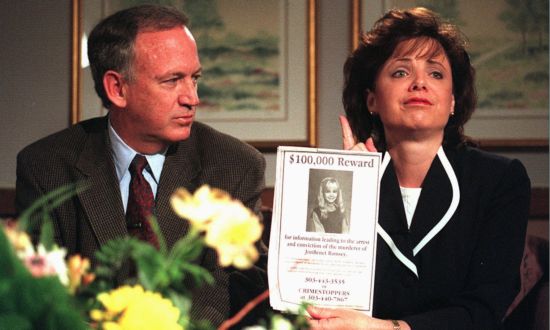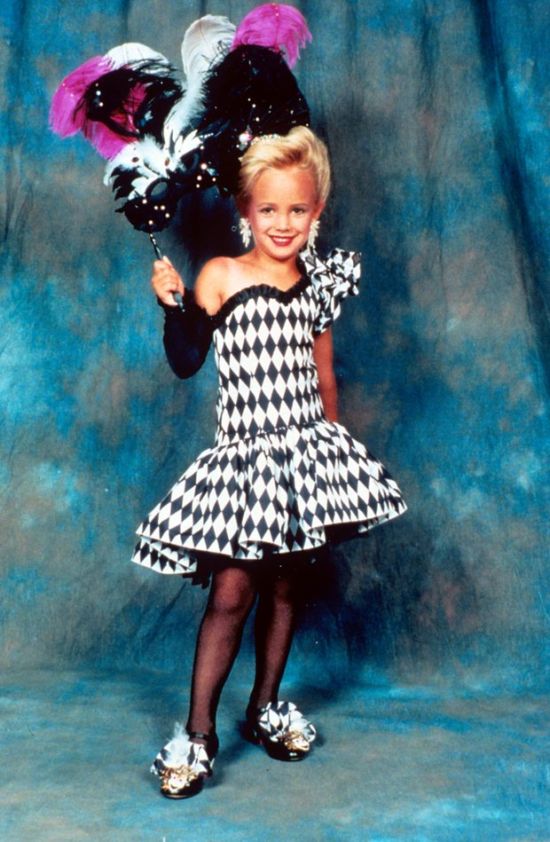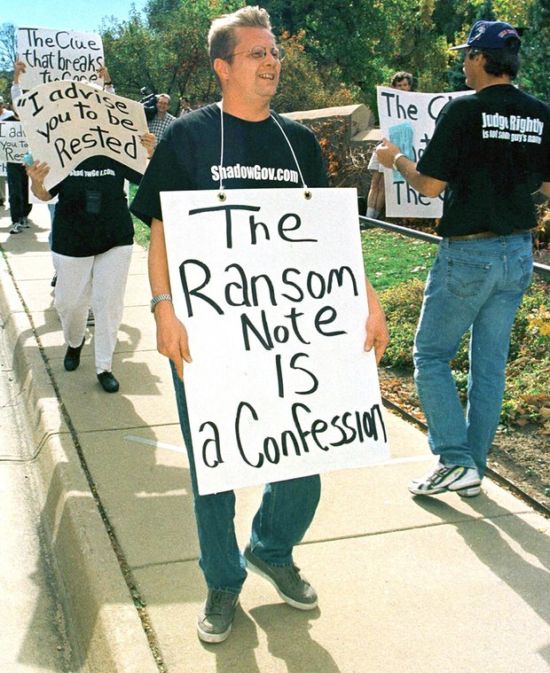|
|
| |
|
Twenty years on, the unsolved killing of
this six-year-old beauty queen is being
raked over in three new documentaries.
Why did the case inspire such ghoulish
hysteria, while her parents, like those
of Madeleine McCann, were demonised and
placed under suspicion? |
| |
 |
|
JonBenét’s parents, in 1997,
hold up an advertisement
promising a reward for
information leading to the
arrest and conviction of their
daughter’s killer. Photograph:
Patrick Davison/AP |
| |
|
|
Such
is the level of suspicion in this story
that even the date of death is deemed
proof of a conspiracy. Twenty years ago,
JonBenét Ramsey, a six-year-old girl
known for ever to the world by the
uncomfortably adult poses she struck in
her beauty pageant photos, was found
bludgeoned and garrotted in her family’s
basement in Boulder, Colorado. The
killer has never been found and, ever
since, the case has been picked over by
experts, the tabloids and an endless
slew of internet obsessives.
It is impossible to overstate how huge
this case was – and still is – in the
United States. Every year, the US media
promise “A chilling new discovery” and
“Latest twist”, even though the case
remains as cold as Christmas in
Colorado. There is now not one single
part of this sad tale that has not been
seized on – by the public, by the
police, by JonBenét’s parents, John and
Patsy – as proof of a coverup, even down
to the child’s gravestone near Atlanta,
Georgia, where she was born. There, the
date of death is literally carved in
stone: 25 December 1996. Yet even this
is seen as a lot less stable than its
material suggests. After all, doubters
say, how could John and Patsy have known
that their daughter died on Christmas
Day if they didn’t find her body until
the early afternoon of the 26th? Surely
the gravestone is evidence of their
guilt that so many have long assumed,
despite them being exonerated in 2008 by
DNA evidence?
The few undisputed facts are as follows:
just before 6am on 26 December, Patsy
called the Boulder police department
from her home. Her daughter had been
taken from their home in the middle of
the night, she said. She had found a
two-and-a-half-page ransom note
demanding $118,000 for her safe return.
The police arrived at the Ramsey house,
along with many of the Ramseys’ friends,
who wandered freely around the property.
After the kidnappers failed to call at
the promised time, one of the officers
suggested to John that he look around
the family’s large house. He went down
to the basement with a friend and there
he saw his daughter, bound and gagged.
When he brought her upstairs, it was
obvious she had been dead for some time.
She had been bashed over the head,
strangled with a garrote fashioned out
of a nylon cord and her mother’s
paintbrush, and possibly sexually
assaulted. There was no immediately
obvious sign of a break-in, and the
house was so large, the perpetrator must
have known its layout very well to have
found JonBenét’s bedroom in the middle
of the night and taken her down to the
basement without waking anyone else.
Some historical crime stories fascinate
the public years later because of what
they say about the times in which they
happened. The OJ Simpson case and the
Manson killings are two obvious
examples, both of which have experienced
a revival of interest this year, thanks
to their retelling in pop culture. The
story of JonBenét Ramsey is different.
The case is certainly in the spotlight
again, with three US networks – CBS, A&E
and Investigation Discovery – all
recently screening their takes on the
case to varying degrees of tackiness.
The media coverage of this case was, and
remains, almost unparalleled in its
tawdriness. Photos of the little girl’s
autopsy were bought and published by US
tabloid the Globe. One journalist
claimed to convert from Judaism to
Christianity in order to attend the
Ramsey’s church and glean insights from
staring at the back of John and Patsy’s
heads. (“I had never seen anyone pray
for his own soul the way Patsy was
praying for hers … At that moment, I
decided she was the killer,” the
journalist, Jeff Shapiro, said in
probably the best-known book about the
case, Lawrence Schiller’s Perfect
Murder, Perfect Town.) The whole story
has long been covered in a thick sheen
of schlock. The only interesting thing
about its historical context is that the
case happened in the aftermath of the OJ
Simpson trial, just when the media was
desperately seeking another case that
would similarly hold the public’s
attention.
But while JonBenét’s murder may well
never be solved, there has never been
any mystery about why it still exerts
such a fascination.
Like Madeleine McCann, JonBenét was a
pretty blond child from a well-off
family, allowing the public the pleasure
of looking at this photogenic child
while simultaneously experiencing a
quiet, unacknowledged frisson of
schadenfreude at her parents’ pain.
Add to this the undeniably sexualised
pageant photos, in which the
six-year-old wiggled and pouted in a
manner that looked all the more
fascinatingly horrific after her brutal
death, and you have the perfect
made-for-media confection. But none of
these factors really explains the
passion this case excites, while also
spotlighting how the public demonises
parents involved in stories we fear
could happen to us.
Pretty much from the moment this story
broke, there have been two theories
about what happened: either JonBenét was
killed accidentally by one or both of
her parents, or her then nine-year-old
brother, Burke, and the parents staged a
faked kidnapping to cover up the
killing; or it was a botched kidnapping
by a mystery outsider. Part of the
reason this case has never been solved
is because the Boulder police department
badly bungled the first few days.
Understaffed during Christmas and wholly
unprepared for such an extraordinary
case, they failed to secure the crime
scene. They didn’t even find JonBenét’s
body in the basement, leaving John to do
so hours later. Their relationship with
the Ramseys completely broke down when
they threatened to refuse to release
JonBenét’s body for burial unless the
Ramseys came in for an interview, and
there were frequent leaks from the
Boulder police department to the media.
“The police were not there to help us.
They were there to hang us,” John Ramsey
has said since. A 2015 Reddit ask me
anything (AMA) discussion with former
Boulder police chief Mark Beckner did
little to disprove the Ramseys’ belief
that the police continue to assume they
were guilty. (Beckner has since
expressed regret for the AMA, saying he
hadn’t realised it would be made
public.) |
| |
 |
|
JonBenét Ramsey. This and
other photographs of her
competing in beauty pageants
helped to turn the public
against the family after her
death. Photograph: Sipa
Press/Rex Features |
| |
|
|
“The biggest mistake in this case is
that there was a phenomenal number of
people who decided on the first day that
they knew what happened, and they would
not allow new information to change
that, and that boggles my mind,” says
journalist and Boulderite, Charlie
Brennan, who has been covering the story
from its first days.
However, it is understandable why the
police suspected the Ramseys. When a
child is killed at home, it is
statistically likely that a parental
figure was involved. The Ramseys,
according to the police, were reluctant
to be interviewed (the Ramseys have
vociferously denied this), and John was
overheard on the phone an hour after
finding JonBenét making arrangements for
his family to leave the state (he has
since said he was just trying to keep
them safe). They were also swift to hire
lawyers – suspiciously quick in the eyes
of many. As for the date on her
gravestone, her parents have since said
they chose it because that was the last
time they saw their daughter.
“The Ramsey case is a criminal Rorschach
test – every piece of evidence can be
looked at in several ways, and I’ve
never seen that in any other case,” says
Brennan. One example of this is the
weirdly long ransom letter, demanding a
very specific amount of money, which
happened to be almost exactly what John
Ramsey had received as a bonus that
year. Even weirder, the note was clearly
written in the Ramseys’ house, using a
pad of paper and pen that were there. To
some, this proves the Ramseys must have
written it: what kidnapper would hang
around to write such a long note? But to
others, this is proof that they didn’t.
Why would the Ramseys mention John’s
bonus in the letter? It must have been
someone with knowledge of his
well-publicised business affairs who
wanted to hurt him. The killer could
have broken in while the family was out
on Christmas Day visiting friends, their
defenders say, and written the note
while they were out, lying in wait until
they went to sleep.
Then there are the pageants. Without
question, the images of the little girl
sashaying on stage in makeup, which were
released without her parents’ consent,
helped to turn public opinion against
the Ramsey family. It certainly turned
many people in Boulder against them.
“Boulder sees itself as a very
sophisticated community and a lot of
people figured that this whole spectacle
was beneath them,” says Brennan. “The
Ramseys had only moved to Boulder a few
years earlier [from Georgia], and then
the whole pageant thing came to light,
which was something that was completely
foreign to most people in Colorado and
more associated with the deep south. So
a lot of Boulderites felt: ‘This does
not reflect us, they are not one of
us.’” As a result, Brennan says: “A lot
of people in Boulder feel there is no
mystery – they know who did it.”
Even JonBenét’s parents seemed divided
about the pageant issue. In their book
about the case, The Death of Innocence,
that they wrote together in alternate
sections, John insists beauty pageants
were just “one of her many hobbies”.
Patsy, however, spends the next seven
pages describing her daughter’s “gift”
at “performing” (she also doesn’t
mention any of her daughter’s other
hobbies). Beauty pageants were unusual
in Colorado, she writes, but she had
done them herself when she was younger.
For one, she bought JonBenét “a Ziegfeld
Follies costume, reminiscent of the one
I had worn in the Miss West Virginia
Pageant some 20 years earlier. Like
mother, like daughter.” |
| |
 |
|
Protesters
unhappy at the lack of a
decision in the murder case
march outside the justice
centre in Boulder, Colorado,
in 1999. Photograph: Reuter |
| |
|
|
So Patsy, in particular, was shocked by
the negative public reaction to the
pageant photos after her daughter’s
murder. One newscaster said the
six-year-old resembled “a hooker”.
Pretty much only pageant photos of
JonBenét were used in the media, even
though she had only been in nine
pageants. There was a definite
intimation in the now-hysterical media
coverage that to put your child in a
beauty pageant was weird, unnatural and
sexually suspect. JonBenét was
simultaneously deified as a photogenic
angel and vilified as a child temptress,
and her parents were criticised for
fetishising her looks, while the public
and media did exactly the same thing
themselves. “What I saw on the pageant
video … you don’t do that to a
six-year-old,” JonBenét’s former dance
teacher, Kit Andrew, says in Perfect
Murder, Perfect Town.
But there is an alternative way of
looking at the pageants. Child beauty
contestants, while unusual in Colorado,
are hardly unknown in the US. Thousands
of pageants still take place every year,
and no one is saying every parent
involved is a potential killer. In fact,
far from incriminating the Ramseys, the
pageant photos could be seen as almost
exonerating them: it could very easily
be argued that the pageants brought
JonBenét to the attention of a local
paedophile, and several have since been
suspected, but never charged.
John and Patsy’s general demeanour was
also deemed suspicious by the police,
the media and the public. “The Ramseys
didn’t appear to behave the way parents
in this situation are ‘supposed’ to
behave. They didn’t cling together and
constantly comfort and reassure each
other,” John Douglas writes in The Cases
That Haunt Us.
But John and Patsy were, they write
themselves, “in shock and medicated so
we could function” for weeks after the
murder. So to judge how they spoke,
looked and interacted as being
indicative of something was not really
fair. But this is what happens to every
parent who loses a child in a
high-profile case: their behaviour is
scrutinised for clues.
When a parent loses a child, the most
natural human response is sympathy. But
that is not what many feel for parents
in high-profile cases.
When Madeleine McCann went missing in
2007, her father, Gerry, and in
particular her mother, Kate, were widely
criticised: Gerry, some sniped, was too
articulate and Kate looked too pretty.
What kind of mother puts on eye shadow
when her daughter is missing?
Kerry Needham was dismissed as a
feckless teenage mother when her baby
son, Ben, went missing on Kos in 1991.
When two-year-old Lane Graves was killed
by an alligator at Disney World in a
freak accident earlier this year,
parenting chat sites were swamped with
people criticising the parents for
letting a little boy play near the water
in the evening, as though that were
unusual on a Florida holiday.
Parent-blaming is all-too-common these
days, and usually the point is to make
other parents feel better about their
own parenting skills. But in cases such
as that of JonBenét, something else is
going on. By demonising parents who have
suffered a terrible trauma, the rest of
us can reassure ourselves that they are
different from us: those parents are
flawed, even evil, and we are good and
therefore our child will never go
missing – in Kos, in Praia de Luz, from
our house in the middle of the night –
like theirs did. The rush to blame
JonBenét’s parents can also be partly
put down to the public needing to
reassure themselves that, contrary to
what the Ramseys said, killers don’t
break into houses and murder children
where they should be most safe. That
only happens when the parents themselves
are killers. And yet.
Brennan says: “In 2000, I wrote a piece
that ran in the Dallas Morning News
pointing out that, nine months after
this crime, someone broke into a house
near the Ramsey house and was in the
process of assaulting a nine-year-old
girl in the middle of the night and was
chased out by her mother. The girl went
to the same dance studio as JonBenét.
The police said they believed it had no
connection to the Ramsey case.”
After writing about the case for 20
years, Brennan says he has come to
believe the family weren’t involved: “If
you look at the autopsy photos and you
see the deep furrow in her neck created
by that ligature, you see a tremendous
amount of force was used. That does not
suggest staging to me – the person who
did it, meant it. But the Ramseys have
nothing in their background to suggest
that this level of evil dwelled in their
hearts,” he says. But this theory, like
the ones about whether the Ramseys
behaved how they were “supposed” to,
relies on imagining how we would behave
if our child had been killed, or if we
had killed them accidentally. But no one
can do that accurately. And anyway, it’s
irrelevant, since the case is about the
Ramseys, not anyone else.
It is entirely possible JonBenét was
killed by a member of her family. It is
also very likely the case will never be
solved: Patsy has since died and the
case gets colder every year. The
ghoulish hysteria around her murder has
lasted more than three times longer than
JonBenét’s life did. “I’ve covered lots
of big stories: the Challenger,
presidential elections. But this – it is
something that I’m thinking about all
the time,” says Brennan. “It is an
impossibly complex, seemingly unsolvable
riddle.” It is also the death of a
child, killed with shocking brutality.
But it’s hard to see the truth beneath
the schlock.
The Killing of JonBenét: Her Father
Speaks, 9pm, 11 December, Crime and
Investigation; Who Killed JonBenét?
Lifetime Movie, 10pm, 18 December; The
Case of JonBenét Ramsey, 22 December,
More4 |
| |
|
|
|
 |
|





